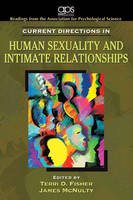
Current Directions in Human Sexuality and Intimate Relationships for Human Sexuality in a World of Diversity
Pearson (Verlag)
978-0-205-72367-6 (ISBN)
- Titel ist leider vergriffen;
keine Neuauflage - Artikel merken
Terri D. Fisher is an Associate Professor of Psychology and Program Coordinator at The Ohio State University at Mansfield where she teaches courses in sexuality and developmental psychology. She received a BA in psychology from Wake Forest University and a PhD in Experimental/Developmental Psychology from the University of Georgia. She served as the President of the Midcontinent Region of the Society for the Scientific Study of Sexuality in 2000 and has been a Consulting Editor for the Journal of Sex Research since 1994. Fisher has published numerous studies on gender and personality differences in sexuality, parent-child communication about sexuality, and contextual effects on the reporting of sexual behavior. She is the co-editor of Speaking of Sexuality: Interdisciplinary Readings and the Handbook of Sexuality-Related Measures. James (Jim) McNulty is an Assistant Professor of Psychology at the University of Tennessee where he teaches undergraduate and graduate courses in social psychology, research methods, and intimate relationships. He received his Ph.D. in social psychology from the University of Florida in 2001 under the tutelage of Benjamin Karney. Through his research, McNulty attempts to understand why initially positive relationship beliefs so frequently become less positive over time. In pursuit of this goal, he has published numerous empirical papers addressing how factors such as expectancies, attributions, forgiveness, and behavior are related to the way marriages develop over time. McNulty was honored with the Early Career Award by the Relationship Researchers Interest Group within the Society for Personality and Social Psychology in 2009 and currently serves as a Consulting Editor for the Journal of Personality and Social Psychology and the Journal of Family Psychology.
INTRODUCTION
SECTION 1: METHODOLOGY AND THEORY
Diamond, L. (2004). Emerging Perspectives on Distinctions Between Romantic Love and Sexual Desire. Current Directions in Psychological Science, 13 (3), 116-119.
Reis, H.T. & W. Collins, W.A. (2004). Relationships, Human Behavior, and Psychological Science. Current Directions in Psychological Science, 13 (6), 233-237.
Karney, B.R. & Bradbury. T.N. (2005). Contextual Influences on Marriage: Implications for Policy and Intervention. Current Directions in Psychological Science, 14 (4), 171-174.
Finkel, E.J. & Eastwick, P.W. (2008). Speed-Dating. Current Directions in Psychological Science, 17 (3), 193-197.
SECTION 2: BIOLOGICAL FOUNDATIONS
McClintock, M.K. & Herdt, G. (1996). Rethinking Puberty: The Development of Sexual Attraction. Current Directions in Psychological Science, 5 (6). 178-183.
Shackelford, T.K. & Aaron T. Goetz, A.T. (2007). Adaptation to Sperm Competition in Humans. Current Directions in Psychological Science, 16 (1), 47-50.
Gangestad, S.W., Thornhill, R. & Garver-Apgar, C.E. & Thornhill, R. (2005). Adaptations to Ovulation: Implications for Sexual and Social Behavior. Current Directions in Psychological Science, 14 (6), 312-316.
Fink, B. & Penton-Voak, I. (2002). Evolutionary Psychology of Facial Attractiveness. Current Directions in Psychological Science, 11 (5),154-158.
Curtis, J.T. & Wang, Z. (2003). The neurochemistry of pair bonding. Current Directions in Psychological Science, 12 (2), 49-53.
SECTION 3: SEX DIFFERENCES
Bjorklund, D.F. & Shackelford, T.K.(1999). Differences in Parental Investment Contribute to Important Differences Between Men and Women. Current Directions in Psychological Science, 8 (3), 86-89.
Miller, L.C., Putcha-Bhagavatula, A. & Pedersen, W.C. (2002). Men's and Women's Mating Preferences: Distinct Evolutionary Mechanisms? Current Directions in Psychological Science, 11(3), 88-93.
Buss, D.M.(2001).Cognitive Biases and Emotional Wisdom in the Evolution of Conflict Between the Sexes. Current Directions in Psychological Science, 10 (6), 219-223.
SECTION 4: SEXUAL ORIENTATION
Savin-Williams, R.C.(2006). Who's Gay? Does It Matter?Current Directions in Psychological Science, 15 (1), 40-44.
Gladue, B.A. (1994). The Biopsychology of Sexual Orientation, Current Directions in Psychological Science, 3 (5), 150-154.
Kurdek, L.A. (2005).What Do We Know About Gay and Lesbian Couples? Current Directions in Psychological Science, 14 (5), 251-254.
Patterson, C.J. (1994). Lesbian and Gay Families. Current Directions in Psychological Science, 3 (2, 62-64.
Herek, G.M. (2000). The Psychology of Sexual Prejudice. Current Directions in Psychological Science, 9 (1),19-22.
SECTION 5: RELATIONSHIP FORMATION AND MAINTENANCE
Furman, W. (2002). The Emerging Field of Adolescent Romantic Relationships. Current Directions in Psychological Science,11 (5),177-180.
Murray, S.L. (2005). Regulating the Risks of Closeness. Current Directions in Psychological Science, 14 (2), 74-78.
Simpson, J.A.(2007). Psychological Foundations of Trust. Current Directions in Psychological Science, 16 (5), 264-268.
Fletcher, G.J. & Simpson, J.A. (2000). Ideal Standards in Close Relationships: Their Structure and Functions. Current Directions in Psychological Science, 9 (3), 102-105.
SECTION 6: CONFLICT, PROBLEMS, AND RISK
Fincham, F.D. (2003). Marital conflict: Correlates, structure, and context.Current Directions in Psychological Science, 12 (1), 23-27.
Huston, T.L., Niehuis, S. & Smith, S.E.(2001). The Early Marital Roots of Conjugal Distress and Divorce. Current Directions in Psychological Science, 10 (4), 116-119.
Drigotas, S.M. & Barta, W.(2001). The Cheating Heart: Scientific Explorations of Infidelity. Current Directions in Psychological Science, 10 (5), 177-180.
Holtzworth-Munroe, A.(2000). A Typology of Men Who Are Violent Toward Their Female Partners: Making Sense of the Heterogeneity in Husband Violence. Current Directions in Psychological Science, 9 (4), 140-143.
Cooper, M.L.(2006).Does Drinking Promote Risky Sexual Behavior?: A Complex Answer to a Simple Question. Current Directions in Psychological Science, 15 (1), 19-23.
| Erscheint lt. Verlag | 26.2.2010 |
|---|---|
| Sprache | englisch |
| Maße | 228 x 154 mm |
| Gewicht | 362 g |
| Themenwelt | Geisteswissenschaften ► Psychologie ► Sexualität / Partnerschaft |
| ISBN-10 | 0-205-72367-5 / 0205723675 |
| ISBN-13 | 978-0-205-72367-6 / 9780205723676 |
| Zustand | Neuware |
| Haben Sie eine Frage zum Produkt? |
aus dem Bereich


